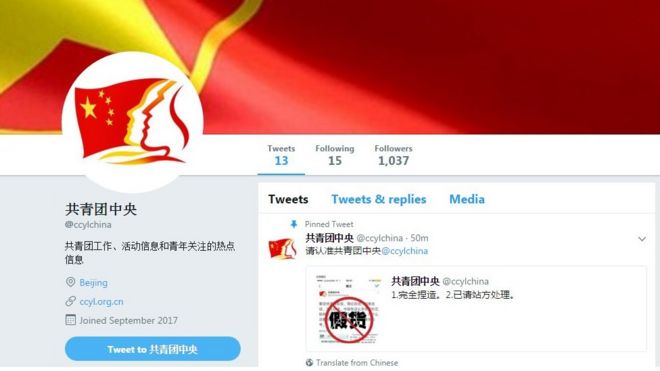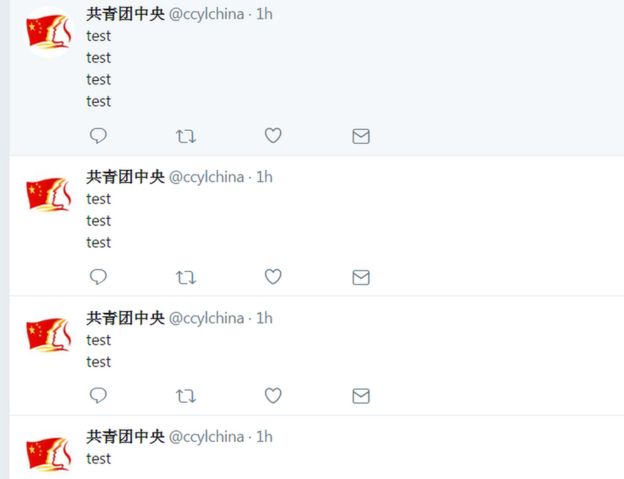 The Twitter account appeared to be set up on Friday.
The Twitter account appeared to be set up on Friday.Setting up a Twitter account may seem a fairly obvious thing for a political party to do, but the step has not so far worked out too well for China's Communist Party.
The account by the party's youth wing made its debut on Friday with a chirpy one-liner -- "I'm here!" -- and a picture of what appeared to be cartoon communist rabbits.
The Twitter bio says the account provides "information on the work and activities of the Communist Party Youth League and hot topics among youths".

It has posted more than dozen times since then -- in Chinese -- covering patriotic topics like the anniversary of the Japanese invasion in 1931 and links to state media articles.
But the posts have been met with a deluge of abusive tweets and questions about how the account has managed to circumvent the "Great Firewall" surrounding China's internet and accusing the youth wing of hypocrisy.
'Go back behind the firewall'
China closely controls what can be posted and seen online, and is steadily tightening its restrictions.
To get round this, Chinese users have always used VPNs to access Twitter and other banned sites by making it seem like their device is in another country.
But dozens of VPN apps have been withdrawn in China in recent weeks after the government issued new rules requiring them to get a licence.
It has also been reining in social media and messaging apps in recent months.
"Go back behind the firewall" and "Give us our VPN" were some of the more popular -- and printable -- responses to @ccylchina.
"Please tell me what kind of miraculous VPN you've used to circumvent the firewall... how brazen you are, you should know that those who do so can be caught!" wrote Twitter user Maoyaodong.
Other criticism referenced Weibo, China's heavily censored Twitter-like microblogging platform.
"Go back behind the firewall" and "Give us our VPN" were some of the more popular -- and printable -- responses to @ccylchina.
"Please tell me what kind of miraculous VPN you've used to circumvent the firewall... how brazen you are, you should know that those who do so can be caught!" wrote Twitter user Maoyaodong.
Other criticism referenced Weibo, China's heavily censored Twitter-like microblogging platform.
One user warned: "This isn't Weibo [where you can] scrub away opinions, get lost."
'Fake news'
One possible reason for the Youth League's debut on Twitter could be the appearance last week of another account, called @ComYouthLeague.
That arrived in a very similar way -- with a tweet, announcing "Hello Twitter" -- and has also been posting patriotic links and news stories.
It met similar questions about firewalls and VPNs, but on Monday, @ccylchina warned its followers it was a fake account, saying: "Please look for the Central Communist Youth League."
It posted a picture -- crossed out -- of a tweet from @ComYouthLeague which talked about respecting China's internet laws.
The ComYouthLeague responded seeming slightly wounded, saying its post was "not fabricated nor fake" but aimed to reflect "the positive energy that Chinese youth should have".
Neither account has yet knocked up a substantial following yet -- in fact @ComYouthLeague is slightly ahead with 1,666 followers at the time of writing.
But that's perhaps unsurprising given the limited Twitter audience in China, where organisations are far more likely to rely on the likes of Weibo to interact with the public.

@Ccylchina seems to be still be finding its feet - it twice posted bursts of "test" tweets on Monday.
Though many Chinese state media outlets have a presence on Twitter, few government and Communist Party bodies maintain accounts.
Those that do include the information office of China's State Council, as well as the main Chinese Communist Party, though its last post was in March 2016.
Though many Chinese state media outlets have a presence on Twitter, few government and Communist Party bodies maintain accounts.
Those that do include the information office of China's State Council, as well as the main Chinese Communist Party, though its last post was in March 2016.
Aucun commentaire:
Enregistrer un commentaire